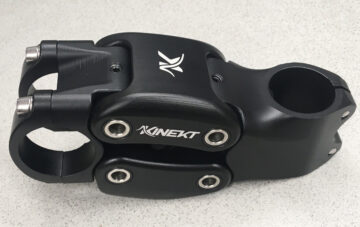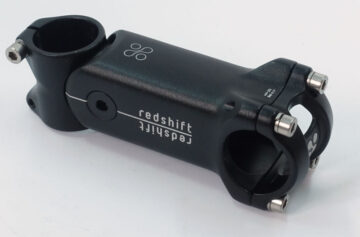The Kinekt Suspension Stem gives a very smooth and comfortable ride, but I found that it’s only suitable for certain types of bikes and the chunky form requires some getting used to the aesthetic. I would recommend this stem to people who want to use it on a more utilitarian rather than a performance bike and want to feel like they’re riding on a cloud. However, in most other situations, I would instead recommend the RedShift ShockStop stem (which I reviewed here) because the fit is more adaptable, it gives a better ride feel and it has a far sleeker look.

Falsely advertised as being “For all riders”
Stems have a major effect on bike fit and riding position and Kinekt claim that the size and angle options offered make it suitable “For all riders” and “fit any bike or riding style”. Unfortunately, they’ve reduced manufacturing costs by only offering the stem in lengths of 15 mm increments (90, 105, 120 mm) instead of the more standard 10 mm; some people may therefore be unlucky and have to buy a stem that’s 7 mm too short or long, which would be quite noticeable and intolerable for me on any bike that I use for riding a reasonable distance. Even more limiting than the 3 length options is that the stem can only be used in the positive rise orientation, not negative.
I don’t have a particularly aggressive position on my gravel or endurance road bikes, but both have quite tall forks and a decent-length head tube. My saddle height is not particularly high given the 54 cm frame size, but I’m very happy with the position using a negative rise stem and minimal or no spacers underneath. Unfortunately, when putting the positive rise Kinekt stem on these bikes it changed my riding position so much that I removed it very quickly. A 105 mm stem, +7 degree angle puts the bars 25 mm higher than would a -7 degree angle (and reduces the reach by 8mm, see this stem comparison tool). I can’t imagine that I’m the only potential purchaser who doesn’t fall into Kinekt’s definition of “all riders” with “any bike or riding style”.
Increased comfort
My electric cargo bike does have a positive rise stem (a Surly Big Dummy with an aftermarket Bafang motor added), so it fits well on that. The extra-long wheelbase, steel frame and large-volume tires make that bike reasonably comfortable already, but the urban roads and paths that I use it on sometimes aren’t so smooth and the fork is rigid. The Kinekt Suspension Stem improved the comfort on that bike considerably and improved bike control by keeping the front wheel more planted on the ground.
The spring in the Kinekt stem is always slightly compressed when riding and responds to all minor bumps in the road. It’s no surprise that the always-engaged feel of the stem is very similar to Kinekt’s Suspension Seatpost, which I reviewed last year: Cirrus Kinekt 2.1 Suspension Seatpost.

I’ve also used the RedShift ShockStop stem and seatpost extensively over the past two years on road and gravel bikes and it was interesting to see how the feel of the Kinekt stem differed. The RedShift stem uses small, internal elastomer dampers to absorb bumps whereas the Kinekt stem uses a far larger, exposed spring.
Whereas with the Kinekt stem and seatpost you are always aware that they are slightly compressed and they are almost constantly moving in response to changes in weight placement while pedaling as well as bumps in the road, it’s easy to forget that the RedShift ShockStop stem and seatpost are there when riding on smooth surfaces, but they do a good job at taking the edge off of bumps when needed. The overall comfort is slightly higher with the Kinekt products, but I prefer the ride feel of the RedShift products.
One advantage that the Kinekt stem has over the RedShift model is that the Kinekt’s parallelogram design allows the movement to be directly in line with the fork, whereas the RedShift stem pivots as it compresses, changing the angle of the bars slightly. When riding with the RedShift stem, I haven’t found this to be very noticeable, even when riding on the brake lever hoods with drop bars, which is the situation in which the pivoting has the most effect, so this characteristic doesn’t bother me, but it again gives a slight comfort advantage to the Kinekt stem.
Kinekt claim that their stem provides 15-20 mm of travel, but when measuring the height difference of the bars between the unweighted position and fully compressed, it’s only 12 mm. I wondered whether it might compress even more when riding, but when I mounted something below the stem that it would have contacted if it had compressed more, it never touched it even when going over large bumps. This doesn’t bother me in terms of function because the stem compresses enough to make the ride comfortable, but it annoys me when brands cannot get their product specifications correct or exaggerate them for marketing purposes. I asked Kinekt to clarify how they measured the travel but received no response.
Aesthetics, weight and price
An important difference between the Kinekt and RedShift seatposts and stems is that the RedShift products are not much larger than standard components and don’t affect the look of the bike very much – many people don’t even notice that there’s anything special about the RedShift stem or seatpost. In contrast, the Kinekt stem and seatpost are far bulkier than standard components and nobody fails to notice them. If you want to preserve the clean lines on a performance bike then the Kinekt suspension stem is not for you.
There is also a noticeable difference in weight, compared to a standard stem weighing 100-200 grams, the RedShift stem weighs almost 300 grams and the Kinekt stem almost 500 grams. As Kinekt claim, this is a lot lighter than a suspension fork (regular suspension forks weight about 1.3-2.0 kg and the carbon Lauf fork is just under 1 kg, compared to a rigid carbon fork at 300-700 grams). I would again choose the RedShift stem based on this characteristic because you can gain a decent amount of comfort while adding a much smaller amount of weight than with the Kinekt stem.
The RedShift stem at US$150 is also cheaper than the Kinekt model at US$180.
Conclusion
The Kinekt Suspension Stem greatly improves ride comfort and for that reason I’m going to continue using it on my electric cargo bike. However, I didn’t find the ride feel, aesthetics or weight to be appropriate for a more performance-oriented bike; when those criteria are important I would recommend the RedShift ShockStop Stem instead.